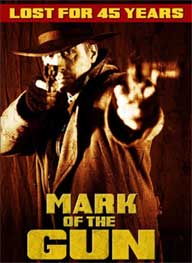 MARK
OF THE GUN (1966)
MARK
OF THE GUN (1966)Director: Wally Campo
Retromedia/Bayview
 MARK
OF THE GUN (1966)
MARK
OF THE GUN (1966)Ross Hagen’s lost western MARK OF THE GUN has been recovered from oblivion for this affordably-priced lovely looking DVD from Retromedia.
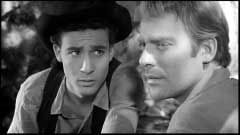
On the run from the law, Justin Kane (Ross Hagen, NIGHT CREATURE) happens upon a brothel run by Beth that also plays host to a band of outlaws lead by Jack (Brad Thomas). Learning that Kane is a skilled fighter and quick-on-the-draw – both by hearsay from comic relief outlaw Bert (Buck Kartalian, PLEASE DON’T EAT MY MOTHER) and after Kane takes out two of his men – Jack decides to recruit Kane on their next bank heist. Jack ruffles the feathers of some of the more aggressive members of the group, as well as Beth when he shows interest in her “untouchable” nineteen-year-old sister Abigail who is naïve enough to still believe that the brothel is a hotel and the girls are just singers and dancers. The gang’s planned heist of the bank in the town of Caliente promises a quarter-of-a-million dollar score (equally divided among the gang and the girls to ensure loyalty); however, they not only have to worry about formidable Sheriff Farrell (Paul Sorensen, HANG ‘EM HIGH), but also a mysterious rival gang that has managed to beat them out three times prior utilizing identical strategies as Jack’s gang (suggesting a spy in their midst).
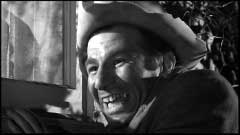
Seemingly the sole directorial effort of actor Wally Campo (BEAST FROM THE HAUNTED CAVE, LITTLE SHOP OF HORRORS), there doesn’t seem to be much reference information on the film. IMDb states a 1969 release date, but the film carries a 1966 copyright. I could find no posters for the film, nor any information on TV syndication or tape releases. Other than the leads, it’s difficult to discover who played whom; Hagen is credited as "The Hero", Thomas as "The Villain" and the rest are listed under "The Girls", "The Gang", and "The Law" (actor Eric Lidberg may have also served as the film’s production manager as “E.J. Lidberg” and Dick Jeffries is credited in the cast and as best boy). MARK OF THE GUN is also another early credit for cinematographer Laszlo Kovacs (as Leslie Kovacs), who emigrated from Hungary with fellow cinematographer Vilmos Zgismond (BLOW OUT) and would work in both low-budget mainstream film (THAT COLD DAY IN THE PARK, TARGETS) and exploitation (MANTIS IN LACE, THE NOTORIOUS DAUGHTER OF FANNY HILL) including (like Zgismond) a couple works by Al Adamson (BLOOD OF DRACULA’S CASTLE, HELL’S BLOODY DEVILS) before moving on to more prestigious assignments like FIVE EASY PIECES and SHAMPOO. The brassy score of Jaime Mendoza-Nava (LEGEND OF BOGGY CREEK) is rather ill-suited to a western. The ambiguous morality of this hero doesn’t allow Hagen – seemingly predating Clint Eastwood’s “Man with No Name” since the earlier Leone films did not get a stateside release until 1967 – to make much of an impression; especially when the supporting outlaws are more colorful. As for his fighting ability, the editing isn’t rapid enough to make one believe he’s a quicker draw than any of the others, and the fight choreography is generally poor and underserved by the foley track (although the opening and closing bits suggest he actually is supposed to be terrible at fisticuffs). Thomas manages to be suitably evil without going over-the-top (especially given the two acts he commits that Kane considers over the line); but Kartalian is most memorable as weasel-y Bert spying on bedroom interludes, robbing corpses, and being ever-so obliging as he is trussed up and has his horse stolen during the climax.
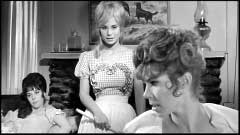
The bulk of the film is set inside and the outside of Beth’s brothel (and some surrounding burnt-out buildings), and the running time is padded out until the last ten minutes with subplot relationships: southerner Homer and northerner “Yank” fight over prostitute Leigh (who briefly becomes the film’s most interesting character when she proclaims her ability to look after herself to Jack), “Kid” Ernie laments to Rita that he’s as yellow as his father (she tells him he hasn’t had a chance to prove himself), Bert and chef Miguel (who Kane later introduces as “my gravedigger” in a possible nod to FISTFUL OF DOLLARS) philosophize about death while stripping the corpses of Kane’s victims of valuables before putting them in the ground, and Beth may have declared Abigail off-limits more out of competition than protectiveness (Beth sleeps with Kane the first night of his stay). The town of Caliente is briefly glimpsed in long shot and the big shootout has the characters photographed from the legs down (meaning that they did not have to hire additional extras, but it also turns out to be necessary to delay the surprise reveal of one of the characters that has only been heretofore mentioned in the dialogue). The climax seems to have been underwritten due to budgetary limitations; however, up until it occurs in the last few minutes, it’s possible to interpret the film as a noir disguised as a western as these fatalistic characters (Abigail tries to convince Kane that anyone is capable of change, but he seems resigned to his on-the-run lifestyle and how it must end) seem as though they will all destroy each other before they even get a chance at the then seemingly fantastical quarter-of-a-million dollar score. The ending scuttles this idea in favor of a more conventional resolution with a comic coda.
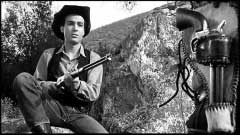 For
a lost picture, MARK OF THE GUN looks pretty good. The print source seems to
have been well-preserved with only a few white specs here and there; however,
the Retromedia’s single-layer, progressive, anamorphic widescreen (1.78:1)
transfer has been treated to quite a bit of edge-enhancement. Close-ups actually
look quite good, but long shots look sharpened and less detailed; still, it’s
the only game in town. The Dolby Digital 2.0 mono track has a faint layer of
hiss and infrequent crackling. The erratic IMDb lists an 85-minute running time
(it also says it’s a color film) but the disc’s 75-minute running
time could be indicative of a film trimmed or styled for double billing or perhaps
a TV print; however, the actress playing Abigail takes a nude dip in the spring
(although it is shown only in extreme long shot and through a gauzy filter)
and a strangulation-by-bullwhip scene is lingering and bloodier (including a
shot of the actor’s throat when the whip is unwound) than any of the bullet
hits (most of which are your standard clutch the area and fall-type deaths).
For
a lost picture, MARK OF THE GUN looks pretty good. The print source seems to
have been well-preserved with only a few white specs here and there; however,
the Retromedia’s single-layer, progressive, anamorphic widescreen (1.78:1)
transfer has been treated to quite a bit of edge-enhancement. Close-ups actually
look quite good, but long shots look sharpened and less detailed; still, it’s
the only game in town. The Dolby Digital 2.0 mono track has a faint layer of
hiss and infrequent crackling. The erratic IMDb lists an 85-minute running time
(it also says it’s a color film) but the disc’s 75-minute running
time could be indicative of a film trimmed or styled for double billing or perhaps
a TV print; however, the actress playing Abigail takes a nude dip in the spring
(although it is shown only in extreme long shot and through a gauzy filter)
and a strangulation-by-bullwhip scene is lingering and bloodier (including a
shot of the actor’s throat when the whip is unwound) than any of the bullet
hits (most of which are your standard clutch the area and fall-type deaths).
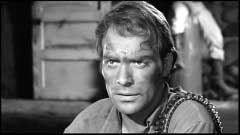 Extras
include a compilation of Ross Hagen trailers under the title “A Fistful
of Ross” (7:24) including FIVE THE HARD WAY (under the title THE SIDEHACKERS),
BAD CHARLESTON CHARLIE, WONDER WOMEN and SUPERCOCK (in which Hagen plays a cowboy
in the Philippines who gets involved in cockfighting, and gets to answer the
customs' question of whether he has anything to declare with “Just my
cock”). Surprisingly, the disc does not include any trailers for Hagen’s
collaborations with director/Retromedia president Fred Olen Ray (Hagen appeared
in nearly twenty Ray films between 1986 and 2000). An extra labeled “Editor’s
Workprint” (2:07) is not extra footage from MARK OF THE GUN, but outtakes
from the Hagen heist film PUSHING UP DAISIES (1973) directed by Ivan Nagy (who
also directed Hagen in BAD CHARLESTON CHARLIE). Not an entirely satisfying effort
(especially for a lost one), but a must for Hagen fans and very affordable.
(Eric
Cotenas)
Extras
include a compilation of Ross Hagen trailers under the title “A Fistful
of Ross” (7:24) including FIVE THE HARD WAY (under the title THE SIDEHACKERS),
BAD CHARLESTON CHARLIE, WONDER WOMEN and SUPERCOCK (in which Hagen plays a cowboy
in the Philippines who gets involved in cockfighting, and gets to answer the
customs' question of whether he has anything to declare with “Just my
cock”). Surprisingly, the disc does not include any trailers for Hagen’s
collaborations with director/Retromedia president Fred Olen Ray (Hagen appeared
in nearly twenty Ray films between 1986 and 2000). An extra labeled “Editor’s
Workprint” (2:07) is not extra footage from MARK OF THE GUN, but outtakes
from the Hagen heist film PUSHING UP DAISIES (1973) directed by Ivan Nagy (who
also directed Hagen in BAD CHARLESTON CHARLIE). Not an entirely satisfying effort
(especially for a lost one), but a must for Hagen fans and very affordable.
(Eric
Cotenas)